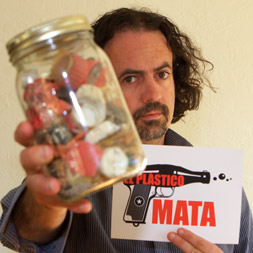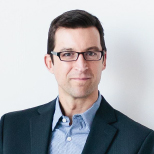June 20, 2013 — Plastics are everywhere and in nearly everything from packaging and toys to medical devices and airplanes. Despite our best efforts to develop more sustainable and Earth-friendly substitutes through green chemistry and other technological advancements, fossil-fuel based plastic use is increasing globally – with a negative impacts on the environment.
In Greek mythology, Sisyphus’s punishment for deceitfulness involved rolling a huge boulder up a hill, only to watch it roll back down through all of eternity.
A beach cleanup on Midway Island in the Pacific Ocean is like Sisyphus’s tale come to life.
Millions of tons of plastics litter the world’s oceans, and these plastics are constantly fragmenting into smaller and smaller pieces.
Contrary to what many people believe, there are no visible islands of trash — even if some areas, the gyres, accumulate higher densities of plastic pollution. In actuality, what is happening is much more complex and scary: Our oceans are becoming a planetary soup laced with plastic.
To make thing worse, these tiny pieces of plastic are extremely powerful chemical accumulators for organic persistent pollutants present in seawater, such as DDEs and PCBs. Members of every level of consumer in the food chain, from filtering invertebrates to marine mammals to us, are eating plastic and/or animals that have plastic in them. In many ways, we carry the garbage patch inside each of us.
Cleaning up this mess is not feasible, technically or economically. The amount of plastic that could hypothetically be captured, at immense cost, would be a drop in the bucket compared to the amount that flows into the ocean every day.
No matter how hard we push, in terms of technology or money, the boulder will be rolling back down the hill, throughout eternity, unless we stop putting more plastics into our environment.
Which brings us to Midway.
Midway Island is a tiny, 2.4-square-mile speck of land located roughly halfway between North America and Asia in the middle of the Pacific.
In 2011 a team of filmmakers, researchers, writers and others led by legendary artist Chris Jordan traveled to Midway to document the effects of global plastic pollution on the island’s Laysan albatross population.

Manuel Maqueda holds a jar containing the stomach contents of a single baby albatross found dead on Midway island. Photo by ElPlasticoMata.com
With the feature film — Midway — scheduled for release later in 2013, Ensia recently caught up with Manuel Maqueda, a founding member of the film team, for an update. Manuel is the driving force behind a number of organizations working to slow plastic pollution, including Kumu, an innovation lab for transformative activism; Plastic Kills and El Plástico Mata, an initiative shining light on the devastation caused by plastic pollution; and Plastic Pollution Coalition, a global alliance of more than 150 organizations working together to stop plastic pollution.
Ensia: What, if anything, has changed on Midway since you finished filming?
Manuel: Awareness has grown tremendously. Over 8 million people have seen the trailer for Midway, and about 20 million have seen some of media that was produced by the team. However, the problem has gotten worse. Since the video was made the world’s production of plastics has continued to grow exponentially, reaching 280 million tons last year. About 40 percent of this amount corresponds to packaging, which is fast track trash, plastics designed to become garbage. This is a very irresponsible use of plastic, being pushed on us by a throwaway culture which is very profitable for a few, to the detriment of all.
Where are most of the plastics coming from?
From all of us. From our homes, schools, businesses and stores. The ocean is downhill and downwind from everywhere, so what we see there is but a tiny representation of a global epidemic. What is more scary is that most of the plastics polluting our oceans, waterway and ecosystems are tiny pieces, as plastic doesn’t biodegrade but fragments into smaller and smaller pieces. Right now there is not a single beach in the world free of plastic particles. Even marine plankton is eating microplastics, as well as fish of all sizes. That means that we, too, like the albatross, are eating plastic. Not surprisingly, an international team of scientists recently asked the governments of the world to declare plastic a hazardous waste.
What can we do to reduce the amount of plastic in the world’s oceans?
We should stop using plastic, a material that lasts hundreds of years, to make disposables —that is, objects designed to become garbage. Plastic packaging has to go, our addiction to throwaway stuff needs to end, and we have to start designing products and processes in a responsible and sustainable way. There is a movement towards bulk products, reusable containers, glass, metal, natural fibers, as well as other smarter ways to deliver goods without generating massive amounts of pervasive, toxic plastic waste. ![]()
Video by: Jan Vozenilek
Written and narrated by: Manuel Maqueda
Music by Christen Lien itsnotaviolin.com
For more information, please visit: MidwayFilm.com
Ensia shares solutions-focused stories free of charge through our online magazine and partner media. That means audiences around the world have ready access to stories that can — and do — help them shape a better future. If you value our work, please show your support today.
Yes, I'll support Ensia!
But yes, we need to address the plastics pollution problem. . .One way is to plastics sustainable; UM researchers are doing this in the Center for Sustainable Polymers (www.csp.umn.edu). See also the video at http://bit.ly/IsOMbf.
How could a toxic, fragmenting material that the plant cannot digest be the perfect material for fast track trash (packaging)? It is the worst possible material, and the devastating consecuences are there to prove it.
Well, it might be perfect... for some. I guess it is perfect only if some privatize the profits and socialize the costs, which is exactly what goes on and has been going on for decades. Huge benefits for a few, to the detriment of everybody.
Packaging is an irresponsible and intolerable use of plastic, and if the industry were held responsible for the true costs, we would see lots of uses of plastic phased out very quickly and better, less wasteful designs kick in very fast
"Sustainable plastics? Sounds great but a lot of what we see coming out of labs can cause as many problems as it seeks to solve. Usually the environmental footprint is huge, sometimes larger than oil based plastics. The biodegradabilty is questionable in many cases. And as long as these "better plastics" also are secret, propietary formulations full of unknown toxic additives we will have the same toxicity issues as we have now.
I don't think the problem is the material as much as the irresponsible uses of plastic that we see today, such as packaging. I still have faith that legitimately sustainable plastics might be produced, but using them to make throwaway coffee stirrers and other dumb things that we only need for a few seconds or minutes would be a shame. I think that first comes better design and better ethics aimed at reducing our wasteful ways. Otherwise these new plastics would be but a band aid on a deeply broken and wasteful system.
I understand that eliminating packaging and food and drink uses kills about half of the market for these new plastics, but I think that's exactly what the planet and our chromosomes would demand –if only could speak.